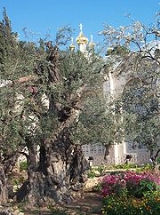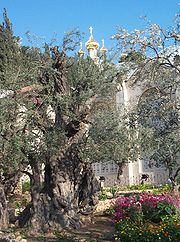
Gethsemane
Encyclopedia

Mount of Olives
The Mount of Olives is a mountain ridge in East Jerusalem with three peaks running from north to south. The highest, at-Tur, rises to 818 meters . It is named for the olive groves that once covered its slopes...
in Jerusalem most famous as the place where, according to Biblical texts, Jesus
Jesus
Jesus of Nazareth , commonly referred to as Jesus Christ or simply as Jesus or Christ, is the central figure of Christianity...
and his disciples are said to have prayed the night before Jesus' crucifixion
Crucifixion of Jesus
The crucifixion of Jesus and his ensuing death is an event that occurred during the 1st century AD. Jesus, who Christians believe is the Son of God as well as the Messiah, was arrested, tried, and sentenced by Pontius Pilate to be scourged, and finally executed on a cross...
.
Etymology
Gethsemane appears in the GreekGreek language
Greek is an independent branch of the Indo-European family of languages. Native to the southern Balkans, it has the longest documented history of any Indo-European language, spanning 34 centuries of written records. Its writing system has been the Greek alphabet for the majority of its history;...
of the Gospel of Matthew
Gospel of Matthew
The Gospel According to Matthew is one of the four canonical gospels, one of the three synoptic gospels, and the first book of the New Testament. It tells of the life, ministry, death, and resurrection of Jesus of Nazareth...
and the Gospel of Mark
Gospel of Mark
The Gospel According to Mark , commonly shortened to the Gospel of Mark or simply Mark, is the second book of the New Testament. This canonical account of the life of Jesus of Nazareth is one of the three synoptic gospels. It was thought to be an epitome, which accounts for its place as the second...
as Γεθσημανἱ (Gethsēmani). The name is derived from the Aramaic
Aramaic language
Aramaic is a group of languages belonging to the Afroasiatic language phylum. The name of the language is based on the name of Aram, an ancient region in central Syria. Within this family, Aramaic belongs to the Semitic family, and more specifically, is a part of the Northwest Semitic subfamily,...
ܓܕܣܡܢ (Gaṯ-Šmānê), meaning "oil press". Matthew (26:36) and Mark (14:32) call it χωρἰον (18:1), a place or estate. The Gospel of John
Gospel of John
The Gospel According to John , commonly referred to as the Gospel of John or simply John, and often referred to in New Testament scholarship as the Fourth Gospel, is an account of the public ministry of Jesus...
says Jesus entered a garden (κῆπος) with his disciples.
Location
According to the New Testament it was a place that Jesus and his disciples customarily visited, which allowed Judas to find him on the night of his arrest.There are four locations claimed to be the place where Jesus prayed on the night he was betrayed.
- The Church of All Nations overlooking a garden with a so-called "Rock of the Agony."
- The location near the Tomb of the Virgin to the north.
- The Greek Orthodox location to the east.
- The Russian Orthodox orchard, next to the Church of Maria MagdaleneChurch of Maria MagdaleneThe Church of Mary Magdalene is a Russian Orthodox church located on the Mount of Olives, near the Garden of Gethsemane in Jerusalem, Israel.-History:...
by an orchard.
Dr. Thomson, author of The Land and the Book, wrote: "When I first came to Jerusalem, and for many years afterward, this plot of ground was open to all whenever they chose to come and meditate beneath its very old olive trees. The Latins, however, have within the last few years succeeded in gaining sole possession, and have built a high wall around it. The Greeks have invented another site a little to the north of it. My own impression is that both are wrong. The position is too near the city, and so close to what must have always been the great thoroughfare eastward, that our Lord would scarcely have selected it for retirement on that dangerous and dismal night. I am inclined to place the garden in the secluded vale several hundred yards to the north-east of the present Gethsemane."
Pilgrimage site

Gospel of Luke
The Gospel According to Luke , commonly shortened to the Gospel of Luke or simply Luke, is the third and longest of the four canonical Gospels. This synoptic gospel is an account of the life and ministry of Jesus of Nazareth. It details his story from the events of his birth to his Ascension.The...
, Jesus' anguish in Gethsemane was so deep that "his sweat was as it were great drops of blood falling down to the ground." According to the Eastern Orthodox Church
Eastern Orthodox Church
The Orthodox Church, officially called the Orthodox Catholic Church and commonly referred to as the Eastern Orthodox Church, is the second largest Christian denomination in the world, with an estimated 300 million adherents mainly in the countries of Belarus, Bulgaria, Cyprus, Georgia, Greece,...
tradition, Gethsemane is the garden where the Virgin Mary was buried and was assumed into heaven
Assumption of Mary
According to the belief of Christians of the Roman Catholic Church, Eastern Orthodoxy, Oriental Orthodoxy, and parts of the Anglican Communion and Continuing Anglicanism, the Assumption of Mary was the bodily taking up of the Virgin Mary into Heaven at the end of her life...
after her dormition on Mount Zion
Mount Zion
Mount Zion is a place name for a site in Jerusalem, the location of which has shifted several times in history. According to the Hebrew Bible's Book of Samuel, it was the site of the Jebusite fortress called the "stronghold of Zion" that was conquered by King David, becoming his palace in the City...
. The Garden of Gethsemane became a focal site for early Christian pilgrim
Pilgrim
A pilgrim is a traveler who is on a journey to a holy place. Typically, this is a physical journeying to some place of special significance to the adherent of a particular religious belief system...
s. It was visited in 333 by the anonymous "Pilgrim of Bordeaux", whose Itinerarium Burdigalense
Itinerarium Burdigalense
The Itinerarium Burdigalense is the oldest known Christian itinerarium, written by an anonymous pilgrim from Burdigala...
is the earliest description left by a Christian traveler in the Holy Land. In his Onomasticon, Eusebius of Caesarea
Eusebius of Caesarea
Eusebius of Caesarea also called Eusebius Pamphili, was a Roman historian, exegete and Christian polemicist. He became the Bishop of Caesarea in Palestine about the year 314. Together with Pamphilus, he was a scholar of the Biblical canon...
notes the site of Gethsemane located "at the foot of the Mount of Olives", and he adds that "the faithful were accustomed to go there to pray". Ancient olive trees growing in the garden are said to be 900 years old.

